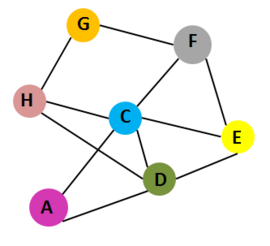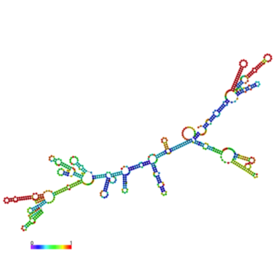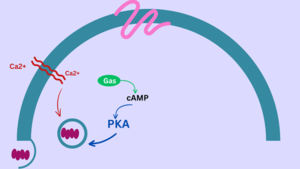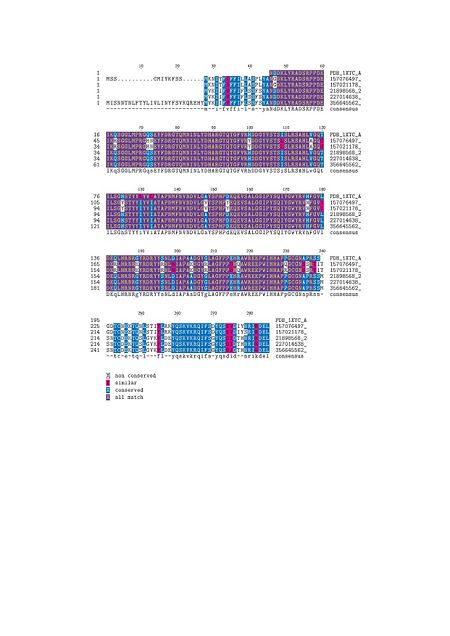Cholera toxin
From Proteopedia
(Difference between revisions)
| Line 17: | Line 17: | ||
== Function == | == Function == | ||
Cholera toxin, after being secreted from the ''Vibrio cholerae'', binds to the enterocytes (intestinal cells) by the interaction between the subunit B and GM1 ganglioside[http://en.wikipedia.org/wiki/GM1] receptor on enterocytes, which then promotes the toxin endocytosis. Next, A1 turns to an active enzyme after separating with the A2 domain. After the A1 domain of subunit A of the toxin enters the cytosol, it activates adenylate cyclase to produce cAMP through G proteins, which triggers the activation of cystic fibrosis transmembrane conductance regulator (CFTR), leading to watery diarrhea: the efflux of water and ions from cells <ref>Jennifer McDowall, Cholera Toxin, EMBL-EMI, Interpro</ref>. | Cholera toxin, after being secreted from the ''Vibrio cholerae'', binds to the enterocytes (intestinal cells) by the interaction between the subunit B and GM1 ganglioside[http://en.wikipedia.org/wiki/GM1] receptor on enterocytes, which then promotes the toxin endocytosis. Next, A1 turns to an active enzyme after separating with the A2 domain. After the A1 domain of subunit A of the toxin enters the cytosol, it activates adenylate cyclase to produce cAMP through G proteins, which triggers the activation of cystic fibrosis transmembrane conductance regulator (CFTR), leading to watery diarrhea: the efflux of water and ions from cells <ref>Jennifer McDowall, Cholera Toxin, EMBL-EMI, Interpro</ref>. | ||
| - | [[Image:Picture1.png| | + | [[Image:Picture1.png|left|300px|thumb|Structure Notation of the RNA of CTX A, CLC RNA Workbench]] |
| + | {{Clear}} | ||
== Evolution == | == Evolution == | ||
CTXφ Bacteriophage which is carried by ''Vibrio cholerae'' produces Cholera toxin. Cholera toxin is encoded by the ctxA and ctxB genes that are introduced into V. cholerae strains by horizontal gene transfer <ref>Davis B, Waldor M (2003). "Filamentous phages linked to virulence of Vibrio cholerae". Curr Opin Microbiol 6 (1): 35–42. doi:10.1016/S1369-5274(02)00005-X. PMID 12615217.</ref>. | CTXφ Bacteriophage which is carried by ''Vibrio cholerae'' produces Cholera toxin. Cholera toxin is encoded by the ctxA and ctxB genes that are introduced into V. cholerae strains by horizontal gene transfer <ref>Davis B, Waldor M (2003). "Filamentous phages linked to virulence of Vibrio cholerae". Curr Opin Microbiol 6 (1): 35–42. doi:10.1016/S1369-5274(02)00005-X. PMID 12615217.</ref>. | ||
Revision as of 13:02, 18 January 2016
| |||||||||||
Contents |
External Links
PDB ID: 1XTC [1]
MMDB ID: 52036 [2]
PubMed[3]
3D Structures of Cholera toxin
Updated on 18-January-2016
See also Toxins
Reference
- ↑ Ryan KJ; Ray CG (editors) (2004). Sherris Medical Microbiology (4th ed.). McGraw Hill. p. 375. ISBN 0838585299.
- ↑ Faruque SM; Nair GB (editors). (2008). Vibrio cholerae: Genomics and Molecular Biology. Caister Academic Press. ISBN 978-1-904455-33-2.
- ↑ Jennifer McDowall, Cholera Toxin, EMBL-EMI, Interpro
- ↑ Jennifer McDowall, Cholera Toxin, EMBL-EMI, Interpro
- ↑ Davis B, Waldor M (2003). "Filamentous phages linked to virulence of Vibrio cholerae". Curr Opin Microbiol 6 (1): 35–42. doi:10.1016/S1369-5274(02)00005-X. PMID 12615217.
- ↑ Luppi P.H.. "The Discovery of Cholera-Toxin as a Powerful Neuroanatomical Tool". Retrieved 2011-03-23.
- ↑ Luppi P.H., Fort P., Jouvet M. Iontophoretic application of unconjugated cholera toxin B subunit (CTb) combined with immunohistochemistry of neurochemical substances: a method for transmitter identification of retrogradely labeled neurons. Brain Res. 534 (1-2) pages : 209-224 (1990)





